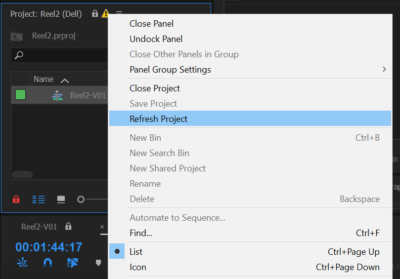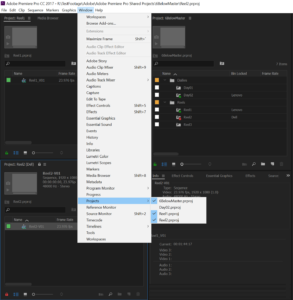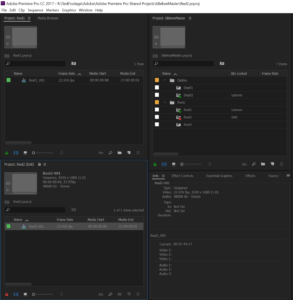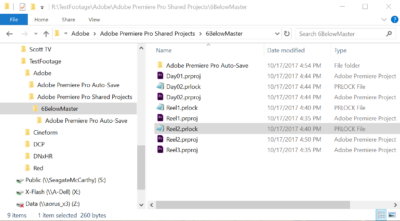Adobe kicked off their Adobe Max conference with the release of their next major update to the video apps available in Creative Cloud. Most of the new features were publicly demonstrated at IBC last month, so this isn’t a surprising development, but there are some pretty significant changes that are worth discussing.
After Effects has a bunch of new functionality for generating motion graphics from existing complex data sets in what is being billed as Data Driven Animations. Both Premiere and AE have much better integration with VR HMDs for editing 360 video. Character Animator is coming out of beta after years of development, with new AI powered features to smooth the process.
 Those are all nice features, but the main thing that everyone has been looking for in this release, is Adobe’s new collaborative workflow features in Premiere Pro. This actually comes as a combination of three separate changes. The first is project locking, which technically was an unannounced feature in last years release. It prevents two people from editing in the same project at the same time, via a sidecar lock file, that denotes who has the file open. Project files can be opened in read only mode, and assets copied out of them, but no changes can be made until unlocked by the existing user, and refreshed by the operator. This prevents people from overwriting each other’s work, and is much more fool proof than the old method, that we liked to call yelling. (“Is anyone in Reel5 right now?”)
Those are all nice features, but the main thing that everyone has been looking for in this release, is Adobe’s new collaborative workflow features in Premiere Pro. This actually comes as a combination of three separate changes. The first is project locking, which technically was an unannounced feature in last years release. It prevents two people from editing in the same project at the same time, via a sidecar lock file, that denotes who has the file open. Project files can be opened in read only mode, and assets copied out of them, but no changes can be made until unlocked by the existing user, and refreshed by the operator. This prevents people from overwriting each other’s work, and is much more fool proof than the old method, that we liked to call yelling. (“Is anyone in Reel5 right now?”)
 The next change is the one that probably has the broadest impact on the widest selection of possible workflows, allowing users to open more than one project simultaneously in Premiere Pro. The projects are completely separate, and can not share assets without duplicating them, but it is easy to copy between them. The magnitude of the effect of this change can not be understated. Technically, similar functionality could previously be achieved by importing sequences between projects, or opening sequences from other projects in the source monitor, but not nearly as conveniently. Adobe envisions breaking down complex projects into many individual .prproj files, usually regarding source material. Footage from every shoot day can be stored in a different project, and could also be migrated to separate projects for every scene, or TV episode, or film reel. Eventually every file used in a native edit will have to be in the same project, but assuming high shooting ratios, this should be far less media than a project starts with. Or episodes and reels can be treated totally separately, and only be combined after exporting flattened files. Either way, large repositories of source footage can be contained in separate projects, and only files in use get brought into projects containing the sequences they are edited into. This results in smaller project files, faster opening times, and lower memory requirements. Combining this with the locking feature allows multiple editors to work on different parts of a larger project simultaneously. They can all have read access to the source media projects, and work within their own sequence projects.
The next change is the one that probably has the broadest impact on the widest selection of possible workflows, allowing users to open more than one project simultaneously in Premiere Pro. The projects are completely separate, and can not share assets without duplicating them, but it is easy to copy between them. The magnitude of the effect of this change can not be understated. Technically, similar functionality could previously be achieved by importing sequences between projects, or opening sequences from other projects in the source monitor, but not nearly as conveniently. Adobe envisions breaking down complex projects into many individual .prproj files, usually regarding source material. Footage from every shoot day can be stored in a different project, and could also be migrated to separate projects for every scene, or TV episode, or film reel. Eventually every file used in a native edit will have to be in the same project, but assuming high shooting ratios, this should be far less media than a project starts with. Or episodes and reels can be treated totally separately, and only be combined after exporting flattened files. Either way, large repositories of source footage can be contained in separate projects, and only files in use get brought into projects containing the sequences they are edited into. This results in smaller project files, faster opening times, and lower memory requirements. Combining this with the locking feature allows multiple editors to work on different parts of a larger project simultaneously. They can all have read access to the source media projects, and work within their own sequence projects.
 The last change that completes this new collaborative workflow is something Adobe has named “Shared Projects” which is not particularly accurate. It allow you to have a project within a project, as an asset. Now you can’t use any of that shared project’s media or sequences within the master project without making duplicate copies within the containing project, after which changes made to them in the sub project will not be reflected in the containing project. You can’t even see what that shared project contains without opening it separately in Premiere. So what can you do with a shared project? You can see if it is in use, and by who. That’s it.
The last change that completes this new collaborative workflow is something Adobe has named “Shared Projects” which is not particularly accurate. It allow you to have a project within a project, as an asset. Now you can’t use any of that shared project’s media or sequences within the master project without making duplicate copies within the containing project, after which changes made to them in the sub project will not be reflected in the containing project. You can’t even see what that shared project contains without opening it separately in Premiere. So what can you do with a shared project? You can see if it is in use, and by who. That’s it.

It’s the same info you could find by looking at the lock files in the project folder. Basically Adobe is trying to copy Avid’s functionality, to help users familiar with that existing workflow make the transition to Premiere.
 There are a few caveats to shared projects that need to be understood. It comes at a cost, in that you can’t increment or version your shared projects, as that would break the link to the containing project. You can increment your sequences, and save your project, but that doesn’t protect you from the possibility of project file corruption. In this case Adobe’s auto-save (or more accurately auto-archiving) is your friend, but make sure you overwrite the corrupt file with the exact name once you confirm a good copy from auto-save. You can’t import an existing project to become a shared project, but can import the contents of a project into a new shared project, or you can save over an existing shared project. If you move a shared project out off the default sub-folder, it can be re-linked like any other asset, when you reopen the containing project, which offers a bit more workflow flexibility. You also could create a shared project within another shared project, but that is a terrible idea, with no benefit that I can imagine, and results in a recursive mess in the file structure if anything goes wrong. If you use the feature exactly the way Adobe intends, it should function well. If not, you can make a mess very quickly. One of the main benefits of the flexibility of Adobe software over its competitors is that it can successfully be used in ways differently than it was designed to be, allowing some very innovative workflows and ideas. Shared projects may not be one of those times, but multiple open projects will be, and will be useful even to editors working on their own.
There are a few caveats to shared projects that need to be understood. It comes at a cost, in that you can’t increment or version your shared projects, as that would break the link to the containing project. You can increment your sequences, and save your project, but that doesn’t protect you from the possibility of project file corruption. In this case Adobe’s auto-save (or more accurately auto-archiving) is your friend, but make sure you overwrite the corrupt file with the exact name once you confirm a good copy from auto-save. You can’t import an existing project to become a shared project, but can import the contents of a project into a new shared project, or you can save over an existing shared project. If you move a shared project out off the default sub-folder, it can be re-linked like any other asset, when you reopen the containing project, which offers a bit more workflow flexibility. You also could create a shared project within another shared project, but that is a terrible idea, with no benefit that I can imagine, and results in a recursive mess in the file structure if anything goes wrong. If you use the feature exactly the way Adobe intends, it should function well. If not, you can make a mess very quickly. One of the main benefits of the flexibility of Adobe software over its competitors is that it can successfully be used in ways differently than it was designed to be, allowing some very innovative workflows and ideas. Shared projects may not be one of those times, but multiple open projects will be, and will be useful even to editors working on their own.

